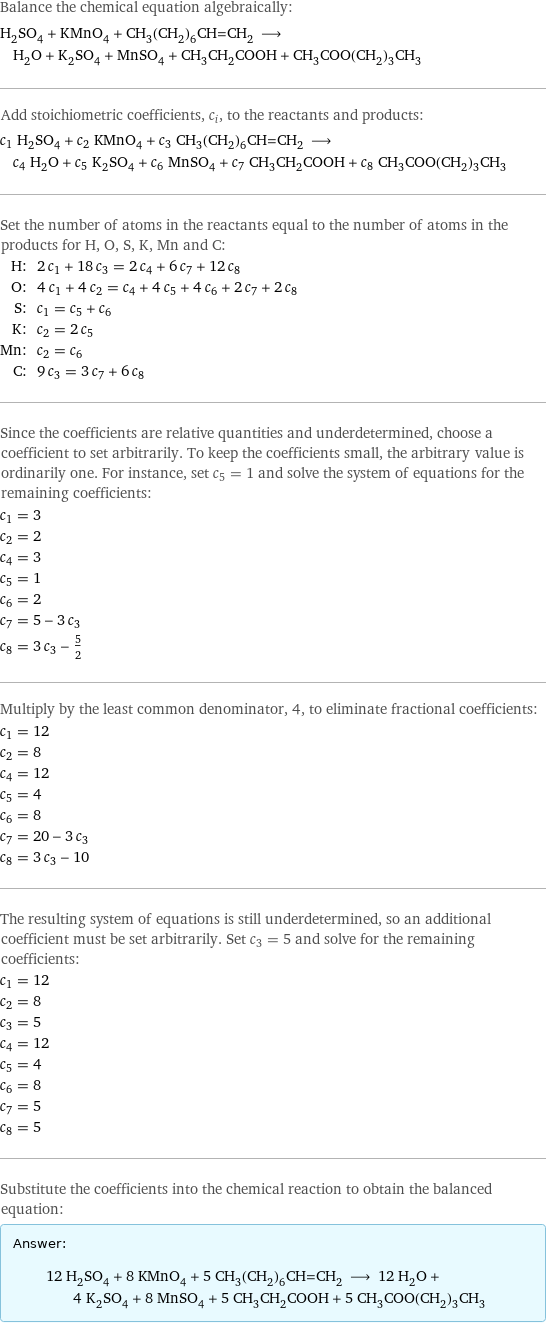Input interpretation

H_2SO_4 sulfuric acid + KMnO_4 potassium permanganate + CH_3(CH_2)_6CH=CH_2 1-nonene ⟶ H_2O water + K_2SO_4 potassium sulfate + MnSO_4 manganese(II) sulfate + CH_3CH_2COOH propionic acid + CH_3COO(CH_2)_3CH_3 butyl acetate
Balanced equation

Balance the chemical equation algebraically: H_2SO_4 + KMnO_4 + CH_3(CH_2)_6CH=CH_2 ⟶ H_2O + K_2SO_4 + MnSO_4 + CH_3CH_2COOH + CH_3COO(CH_2)_3CH_3 Add stoichiometric coefficients, c_i, to the reactants and products: c_1 H_2SO_4 + c_2 KMnO_4 + c_3 CH_3(CH_2)_6CH=CH_2 ⟶ c_4 H_2O + c_5 K_2SO_4 + c_6 MnSO_4 + c_7 CH_3CH_2COOH + c_8 CH_3COO(CH_2)_3CH_3 Set the number of atoms in the reactants equal to the number of atoms in the products for H, O, S, K, Mn and C: H: | 2 c_1 + 18 c_3 = 2 c_4 + 6 c_7 + 12 c_8 O: | 4 c_1 + 4 c_2 = c_4 + 4 c_5 + 4 c_6 + 2 c_7 + 2 c_8 S: | c_1 = c_5 + c_6 K: | c_2 = 2 c_5 Mn: | c_2 = c_6 C: | 9 c_3 = 3 c_7 + 6 c_8 Since the coefficients are relative quantities and underdetermined, choose a coefficient to set arbitrarily. To keep the coefficients small, the arbitrary value is ordinarily one. For instance, set c_5 = 1 and solve the system of equations for the remaining coefficients: c_1 = 3 c_2 = 2 c_4 = 3 c_5 = 1 c_6 = 2 c_7 = 5 - 3 c_3 c_8 = 3 c_3 - 5/2 Multiply by the least common denominator, 4, to eliminate fractional coefficients: c_1 = 12 c_2 = 8 c_4 = 12 c_5 = 4 c_6 = 8 c_7 = 20 - 3 c_3 c_8 = 3 c_3 - 10 The resulting system of equations is still underdetermined, so an additional coefficient must be set arbitrarily. Set c_3 = 5 and solve for the remaining coefficients: c_1 = 12 c_2 = 8 c_3 = 5 c_4 = 12 c_5 = 4 c_6 = 8 c_7 = 5 c_8 = 5 Substitute the coefficients into the chemical reaction to obtain the balanced equation: Answer: | | 12 H_2SO_4 + 8 KMnO_4 + 5 CH_3(CH_2)_6CH=CH_2 ⟶ 12 H_2O + 4 K_2SO_4 + 8 MnSO_4 + 5 CH_3CH_2COOH + 5 CH_3COO(CH_2)_3CH_3